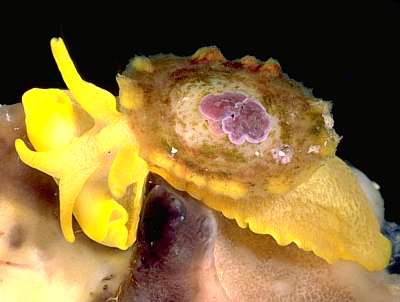
Tylodina corticalis
(Tate, 1889)
Order: NOTASPIDEA
Superfamily: TYLODINOIDEA
Family: Tylodinidae
DISTRIBUTION
From southern Queensland, south around the southern Australian coast to south western Australia.
PHOTO
Solitary Islands, Coffs Harbour Region, northern New South Wales, March 1988, 50mm long alive. On its food sponge Pseudoceratina sp. (Order Verongida, Family Aplysinellidae). PHOTO: Bill Rudman.
Tylodina corticalis is a primitive notaspid, with a large heavily calcified external shell. It has some similarities to Umbraculum umbraculum in the shape of its shell, but the external shape of the body, with large head and retractile penis is quite different. It is found from the intertidal down to about 100 meters, usually on its food sponge Pseudoceratina sp.(Family Aplysinellidae, Order Verongida). Very similar species are found in the Mediterranean, on the east and west coasts of North America, and southern Africa, where they eat related sponges. When crawling, the bright yellow body becomes elongate extending some distance in front and behind the shell, unlike Umbraculum, which is a much more circular in shape.
Reference:
• Willan, R.C. (1984). A review of diets in the Notaspidea (Mollusca:Opisthobranchia). Journal of the Malacological Society of Australia, 6: 125-142.
Rudman, W.B., 1999 (March 7) Tylodina corticalis (Tate, 1889). [In] Sea Slug Forum. Australian Museum, Sydney. Available from http://www.seaslugforum.net/find/tylocort
Related messages
Tylodina corticalis on food source
February 8, 2008
From: Gary Cobb
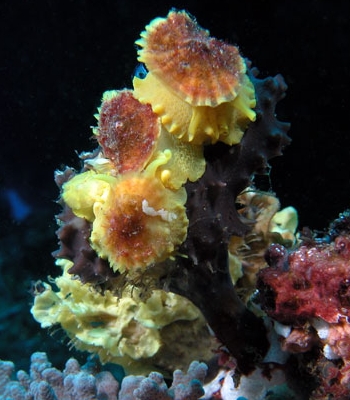
Hi Bill and everyone!
When on a dive you never know what you'll find. My dive buddy was trying to get my attention while shooting a Flabellina bicolor... boy was I surprised! Six Tylodina corticalis attacking a sponge. Could this be Pseudoceratina sp.? I shot a pic after prying them off to show what they ate. The largest one is 46 mm.
Locality: Hanging Rock, Mooloolaba, 17 m, Queensland, Australia, Pacific Ocean, 08 December 2007, Subtidal. Length: 12-46 mm. Photographer: Gary Cobb.
Cheers
Gary Cobb
gary@nudibranch.com.au
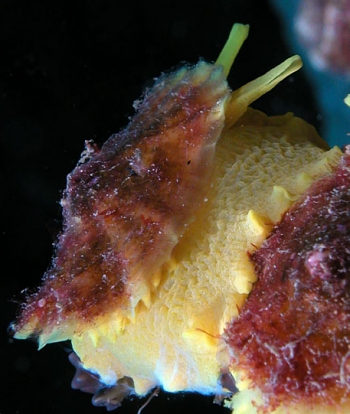
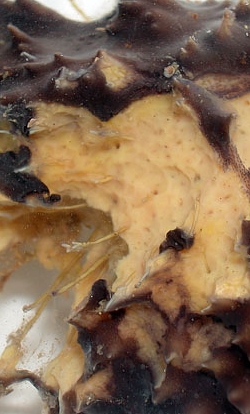
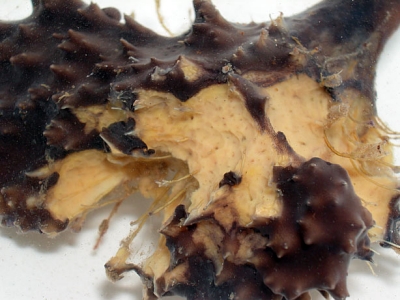
00Dear Gary,
This is a nice find, and yes I am sure this is either a species of Pseudoceratina or else a closely related sponge of the Family Aplysinellidae. Species of Tylodina feed on this group of sponges worldwide. The aplysinellids and the related verongiid sponges have an interesting and well-studied group of defensive chemicals which I guess the tylodinids are re-using for their own defense.
Best wishes,
Bill Rudman
Tylodina corticalis - shell variability
June 5, 2006
From: Bill Rudman
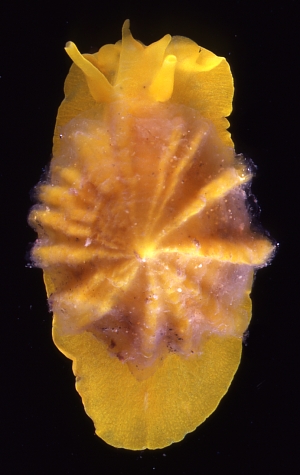
In response to Kevin Lee's message [#16722] about variability in shell shape in Tylodina fungina I looked out some photos of the southeastern and southern Australian species, T. corticalis. In the other two messages [ #16799, #16801], the shells are quite flattened, but at times animals are found with prominent radial ribbing on the shell, making them look quite like some species of the pulmonate limpet Siphonaria. At one time I thought the ribbed shells were a southern feature, but Gary Cobb's photo from southern Queensland [#10630 ], certainly proves that to be an unsupportable hypothesis.
Locality: Port Lonsdale, west head, Port Philip Bay, Victoria, 21 April 1980. on kelp (Laminaria ) in tide pools. 3 animals - 15, 21, 32 mm live found, largest photographed. AM C121669. Photo: Bill Rudman.
Best wishes
Bill Rudman
Tylodina corticalis - feeding juvenile
June 5, 2006
From: Bill Rudman
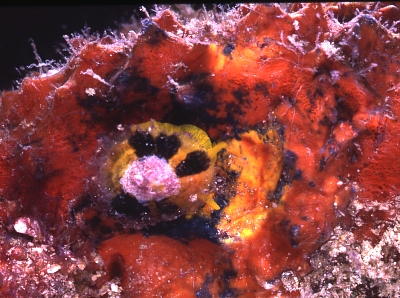
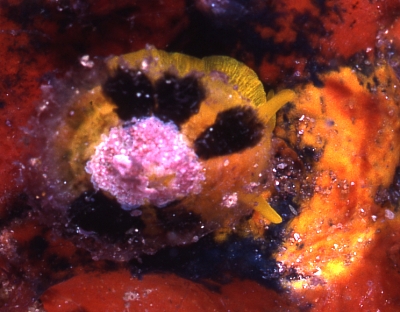
Here is a photo of a relatively small Tylodina corticalis, to accompany my other messages [#16800, #16801].
This animal also has a flattened shell and at least the outer third is uncalcified, suggesting a rapid growth rate. It is very well camouflaged on its food sponge, Pseudoceratina sp. (Order Verongida, Family Aplysinellidae) which is bright yellow inside but usually has a brown outer layer, oftem with dark blackish brown patches. In this photo you can see the bright yellow patch by the head, which is where the slug has been feeding. Often juveniles have dark brown patches on the shell, which I assume is a camouflage technique. As the animals grow the brown patches usually disappear or can become radiating lines flanking the ridges which some shells have. Like the similar Umbraculum, the shell often has algal growths on it. The pink growth on this animal's shell is some encrusting red algae.
Locality: South side of Split Solitary Iisland, Coffs Harbour, nthn New South Wales, Australia.. 3 March 1988, Shell length 15 mm. AM C155704. Photo: Bill Rudman.
Best wishes
Bill Rudman
Very large Tylodina corticalis from SE Australia
June 5, 2006
From: Bill Rudman
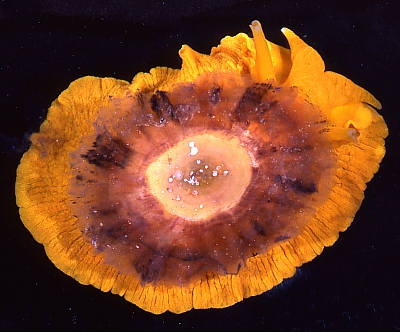
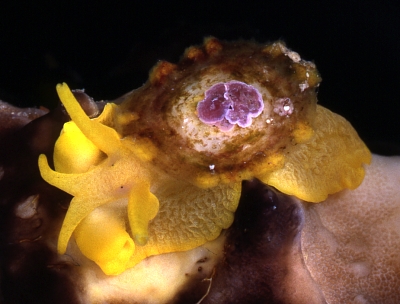
Following on from my comments to Kevin Lees's message [#16762] on the large size of his Tylodina fungina, here is a record of a very large animal of Tylodina corticalis, as species from temperate Australian waters, which normally is found growing up to 50 mm long, but its is usually a bit smaller than that. The upper photo is of a huge specimen, about 120 mm long, from Jervis Bay, in southern New South Wales. It is not fully extended in this photo but had the same body shape as the lower animal.
Upper Photo: off Bowen Island, Jervis Bay, New South Wales, Australia. Depth: approx 20 ft. coll J. Lowry, H. Stoddard, 3 June, 1981. Shell 55 mm long - at least 1cm of that is soft uncalcified growth. Animal appproz 120 mm long alive. AM C130163. Photo: Bill Rudman.
Lower Photo: Nthn side of Split Solitary Island, Coffs Harbour, New South Wales, Australia. 15 m. 14 March 1988. shell 28 mm long, animal 50 mm long alive. On its food sponge Pseudoceratina sp. (Order Verongida, Family Aplysinellidae). AM C155732. Photo: Bill Rudman.
As I have mentioned before, small whitish glands all over the body produce a milky yellow mucus secretion. The animal can also can produce a deep blue secretion when disturbed - source uknown
Best wishes
Bill Rudman
Tylodina corticalis from New South Wales
August 14, 2003
From: Leanne & David Atkinson
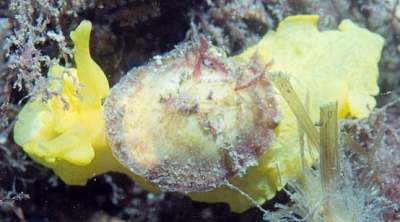
Dear Bill,
After reading Gary Cobb's message about Tylodina corticalis we remembered we had some shots of it in the Port Stephens area. You didn't have any from there on the Forum, so here are three shots, the third one shows some of the foot. These are not a common sight but we have seen it on more than one occasion.
Upper Photo: Halifax Sponge Gardens, Marine Reserve, Port Stephens, NSW, Australia
Date: January 2000 Tide: High
Depth: 10m
Lower Photos: Little Beach, Marine Reserve, Port Stephens, NSW, Australia
Date: 29.12.02 Time: 5:15pm
Depth: 13m Tide: High Water Temp.: 19degreesC
Regards,
Leanne & David Atkinson
atk@hunterlink.net.au
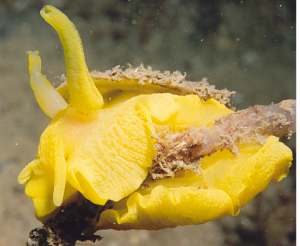
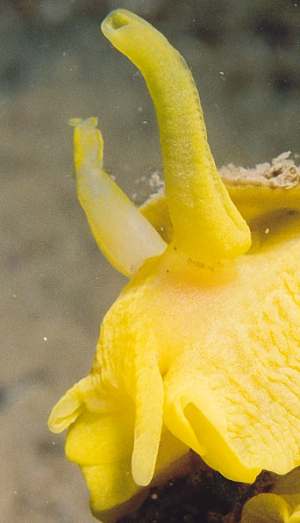
Dear Leanne & David,
Thanks for these photos. I have included a close-up of the head of the Little Bay animal as it shows the structure of the rhinophores and oral tentacles very well. The rhinophores are an open rolled cylinder at the top - much like in a species of Elysia - but a littl eway doown from the tip they become a solid structure with a groove down the outer edge. You can see this groove in the left rhinophore in the photo. The oral tentacles are enrolled [see right tentacle in photo] much the the Elysia rhinophore.
Best wishes,
Bill Rudman
Tylodina corticalis from sthn Queensland
August 5, 2003
From: Gary Cobb
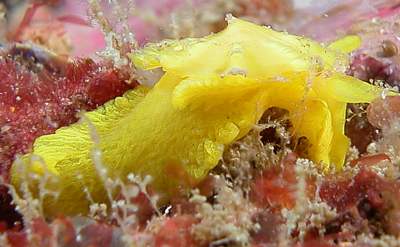

Hi Bill!
Please find attached a couple photos of Tylodina corticalis I took this weekend [July 2003] at a site called Fairyland off Mooloolaba in 16m [Mooloolaba, Sunshine Coast, south east Queensland, Australia].
You can see the gill quite easily. This one was about 1cm long
Gary Cobb
gary@cobb.com.au
Cobb, G., 2003 (Aug 5) Tylodina corticalis from sthn Queensland. [Message in] Sea Slug Forum. Australian Museum, Sydney. Available from http://www.seaslugforum.net/find/10630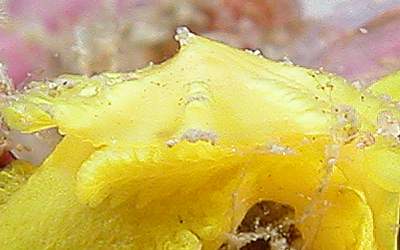
Thanks Gary,
These shots certainly show the large gill on the right side of the body very clearly.
Best wishes,
Bill Rudman
Tylodina corticalis from Lord Howe Island
January 21, 2003
From: W.B. Rudman
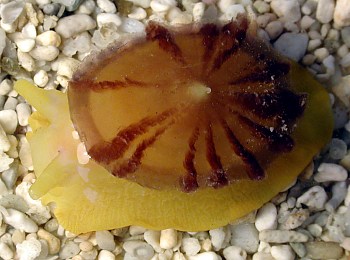
Here is a photo record from Ian Hutton of Tylodina corticalis from Lord Howe Island.
Location: Far Rocks.
Bill Rudman
Rudman, W.B., 2003 (Jan 21) Tylodina corticalis from Lord Howe Island. [Message in] Sea Slug Forum. Australian Museum, Sydney. Available from http://www.seaslugforum.net/find/8988Tylodina corticalis from New South Wales
April 4, 2001
From: Erik Schloegl
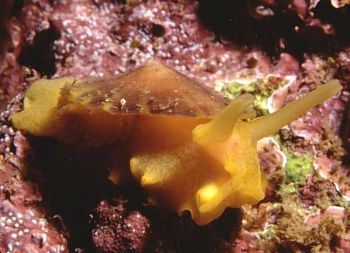
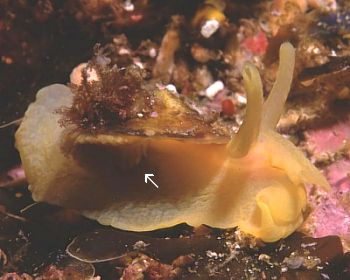
Dear Bill,
Here are two photos of Tylodina corticalis. In both you can see the animal's gills quite nicely.
The UPPER photo was taken at "The Gap", just south of the entrance to Sydney Harbour, New South Wales, on 14 March, 1998. The depth was 20m, the water temperature 20 C.
The LOWER photo was taken at the northern end of Montague Island, southern New South Wales, on 24 January, 2000. The depth was 25m, the water temperature not recorded.
Best wishes,
Erik
Erik.Schlogl@uts.edu.au
Schloegl, E., 2001 (Apr 4) Tylodina corticalis from New South Wales. [Message in] Sea Slug Forum. Australian Museum, Sydney. Available from http://www.seaslugforum.net/find/4090Thanks Erik,
These photos show their external characteristics very well. The order name Notaspidea means 'back shield' which is a reference to the large external shell on it back. And the common name Side-Gilled Slug is a reference to the position of the gill on the right side of the body (see arrow I have added to Erik's lower photo).
Best wishes,
Bill Rudman
